Penetration Behavior of High-Density Reactive Material Liner Shaped Charge
Abstract
:1. Introduction
2. High-Density Reactive Material Liners
2.1. Reactive Liner Materials
2.2. Reactive Material Liner Preparation
- (1)
- First, the powders were mixed by a planetary mill machine for 3 h, with a small amount of absolute alcohol as a medium. Then, the powders were dried at 82 °C in a vacuum drying oven for 24 h approximately.
- (2)
- Second, 45.0 g of well-mixed powder was weighed and placed in a pressing mold. A cold pressing pressure of 450 MPa was maintained for 30 s. The pressed liner samples were then relaxed at ambient pressure and temperature for 24 h in order to remove trapped air and residual stress.
- (3)
- Third, the pressed liner samples were then sintered in a nitrogen atmosphere with a maximum temperature of 380 °C. Figure 1 shows the temperature history of the sintering cycle, which can be described as follows: the oven temperature was raised to 200 °C at a rate of about 10 °C/min, and then upgraded to 380 °C at a rate of about 2 °C/min. The samples were held at 380 °C for 4 h, then the temperature was reduced at a rate of about 0.5 °C/min to 315 °C and maintained for 4 h. The sintered liner samples were then cooled to ambient temperature at an average cooling rate of 1 °C/min.
3. X-Ray Experiments
3.1. High-Density Reactive Material Liner Shaped Charge
3.2. X-ray Experimental Setup
3.3. X-ray Results
4. Penetration Experiments
4.1. Experimental Setup
4.2. Penetration Performance
4.3. Penetration Comparison
5. Reaction Mechanism and Penetration Model
5.1. Reaction Mechanism
5.2. Penetration Model
6. Conclusions
- (a)
- The X-ray test results demonstrated that the PTFE/W/Cu/Pb high-density reactive material liner could form a reactive jet with excellent performance under the shaped charge effects, including the distinct jet outline, the clear jet tip and rear, and the satisfied jet continuity.
- (b)
- The results of penetration experiment indicated that, with the standoff increasing from 0.5 CD to 2.0 CD, the penetration depth of the PTFE/W/Cu/Pb reactive jet first increased and then decreased, and the penetration depth could be up to 2.82 CD when the standoff was 1.5 CD. At the same standoff of 1.5 CD, the penetration depth of the PTFE/W/Cu/Pb reactive jet was significantly larger than that of the traditional PTFE/Al reactive jet, but lower than that of the metal copper jet.
- (c)
- The PTFE/W/Cu/Pb high-density reactive jet only occurs with limited and local chemical reactions within the reaction delay time, which indicates that kinetic penetration should be the main defeat mechanism. Once obtaining the reaction delay time, the reactive jet inside the target experiences violent deflagration reactions, releasing large amounts of high-temperature gaseous products, which leads to a sharp pressure rise inside the penetration crater and improves the radial flowing of the target material.
Author Contributions
Funding
Acknowledgments
Conflicts of Interest
References
- Raftenberg, M.N.; Mock, W.; Kirby, G.C. Modeling the Impact Deformation of Rods of a Pressed PTFE/Al Composite Mixture. Int. J. Impact Eng. 2008, 35, 1735–1744. [Google Scholar] [CrossRef]
- Chang, B.H.; Yin, J.P.; Cui, Z.Q.; Liu, T.X. Numerical simulation of modified low-density jet penetrating shell charge. Int. J. Simul. Model 2015, 14, 426–437. [Google Scholar] [CrossRef]
- Baker, E.L.; Daniels, A.S.; Ng, K.W.; Martin, V.O.; Orosz, J.P. Barnie: A unitary demolition warhead. In Proceedings of the 19th International Symposium on Ballistics, Interlaken, Switzerland, 7–11 May 2001. [Google Scholar]
- Nicolich, S. Reactive materials enhanced lethality EFP. In Proceedings of the 42nd Annual Armament Systems: Gun and Missile Systems Conference and Exhibition, Charlotte, NC, USA, 23–26 April 2007; National Defence Industrial Association: Arlington, VA, USA, 2007. [Google Scholar]
- Daniels, A.S.; Baker, E.L.; De Fisher, S.E.; Ng, K.W.; Pham, J. Bam bam: Large scale unitary demolition warheads. In Proceedings of the 23rd International Symposium on Ballistics, Tarragona, Spain, 16–20 April 2007. [Google Scholar]
- Xiao, J.G.; Zhang, X.P.; Wang, Y.Z.; Xu, F.Y.; Wang, H.F. Demolition mechanism and behavior of shaped charge with reactive liner. Propellants Explos. Pyrotech. 2016, 41, 612–617. [Google Scholar] [CrossRef]
- Xiao, J.G.; Zhang, X.P.; Guo, Z.X.; Wang, H.F. Enhanced damage effects of multi-layered concrete target produced by reactive materials liner. Propellants Explos. Pyrotech. 2018, 43, 955–961. [Google Scholar] [CrossRef]
- Zhang, X.P.; Xiao, J.G.; Yu, Q.B.; Zheng, Y.F.; Wang, H.F. Armor penetration aftereffect overpressure produced by reactive material liner shaped charge. Acta Armamentarii 2016, 37, 1388–1394. [Google Scholar]
- Guo, H.G.; Zheng, Y.F.; Tang, L.; Yu, Q.B.; Ge, C.; Wang, H.F. Effect of wave shaper on reactive materials jet formation and its penetration performance. Def. Technol. 2019, 15, 495–505. [Google Scholar] [CrossRef]
- Guo, H.G.; Zheng, Y.F.; Yu, Q.B.; Ge, C.; Wang, H.F. Penetration behavior of reactive liner shaped charge jet impacting steel plates. Int. J. Impact Eng. 2019, 126, 76–84. [Google Scholar] [CrossRef]
- Yi, J.Y.; Wang, Z.J.; Yin, J.P.; Zhang, Z.M. Simulation study on expansive jet formation characteristics of polymer liner. Materials 2019, 12, 744. [Google Scholar] [CrossRef] [PubMed]
- Church, P.; Claridge, R.; Ottley, P.; Lewtas, I.; Harrison, N.; Gould, P.; Williamson, D.; Braithwaite, C. Investigation of a Nickel-Aluminum reactive shaped charge liner. J. Appl. Mech. 2013, 80, 031701. [Google Scholar] [CrossRef]
- Sun, M.; Li, C.; Zhang, X.; Hu, X.; Hu, X.; Liu, Y. Reactivity and Penetration Performance Ni-Al and Cu-Ni-Al Mixtures as Shaped Charge Liner Materials. Materials 2018, 11, 2267. [Google Scholar] [CrossRef] [PubMed]
- Evers, J.; Klapötke, T.M. Use of intermetallic alloys as reactive materials for warhead applications. Chin. J. Explos. Propellants 2015, 38, 8–10. [Google Scholar]
- Li, Y.; Jiang, C.L.; Wang, Z.C.; Niu, H.H. Experimental study on impact-induced reaction characteristics of PTFE/Ti composites enhanced by W particles. Materials 2017, 10, 175. [Google Scholar] [CrossRef] [PubMed]
- Zheng, Y.F.; Su, C.H.; Guo, H.G.; Yu, Q.B.; Wang, H.F. Behind-target rupturing effects of sandwich-like plates by reactive liner shaped charge jet. Propellants Explos. Pyrotech. 2019, 44, 1–11. [Google Scholar] [CrossRef]
- Wang, H.F.; Guo, H.G.; Geng, B.Q.; Yu, Q.B.; Zheng, Y.F. Application of PTFE/Al Reactive Materials for Double-Layered Liner Shaped Charge. Materials 2019, 12, 2768. [Google Scholar] [CrossRef] [PubMed]
- Zygmunt, B.; Wilk, Z. Formation of jets by shaped charges with metal powder liners. Propellants Explos. Pyrotech. 2008, 33, 482–487. [Google Scholar] [CrossRef]
- Voitenko, Y.I.; Goshovskii, S.V.; Drachuk, A.G.; Bugaets, V.P. Mechanical Effect of shaped charge with Porous Liners. Combust. Explos. Shock Waves 2013, 49, 109–116. [Google Scholar] [CrossRef]
- Osborne, D.T.; Pantoya, M.l. Effect of al particle size on the thermal degradation of al/teflon mixtures. Combust. Sci. Technol. 2007, 179, 1467–1480. [Google Scholar] [CrossRef]
- Dipersio, R.; Simon, J. The Penetration-Standoff Relation for Optimumized Shaped Charge Jets; BRL Memorandum Report No. 1542; Ballistic Research Laboratory: Aberdeen Proving Ground, MD, USA, 1964. [Google Scholar]
- Huang, Z.X. Theory and Practice of Shaped Charge; Beijing Institute of Technology Press: Beijing, China, 2014; pp. 67–79. [Google Scholar]
- Zhang, X.F.; Shi, A.S.; Zhang, J.; Qiao, L.; He, Y.; Guan, Z.W. Thermochemical modeling of temperature controlled shock-induced chemical reactions in multifunctional energetic structural materials under shock compression. J. Appl. Phys. 2012, 111, 123501. [Google Scholar] [CrossRef]
- Ames, R.G. Energy Release Characteristics of Impact-Initiated Energetic Materials; Materials Research Society: Triangle Park, NC, USA, 2006. [Google Scholar]
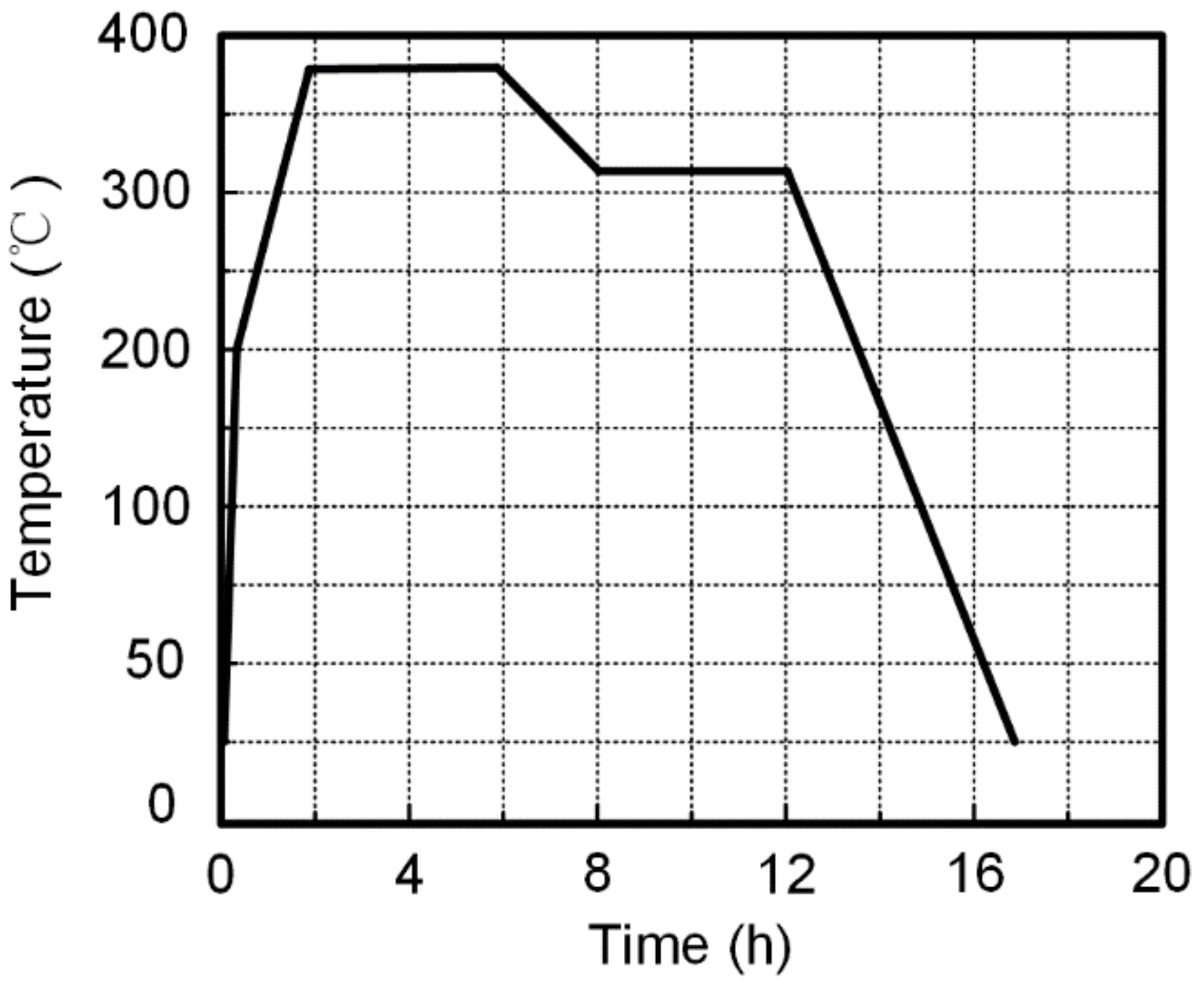
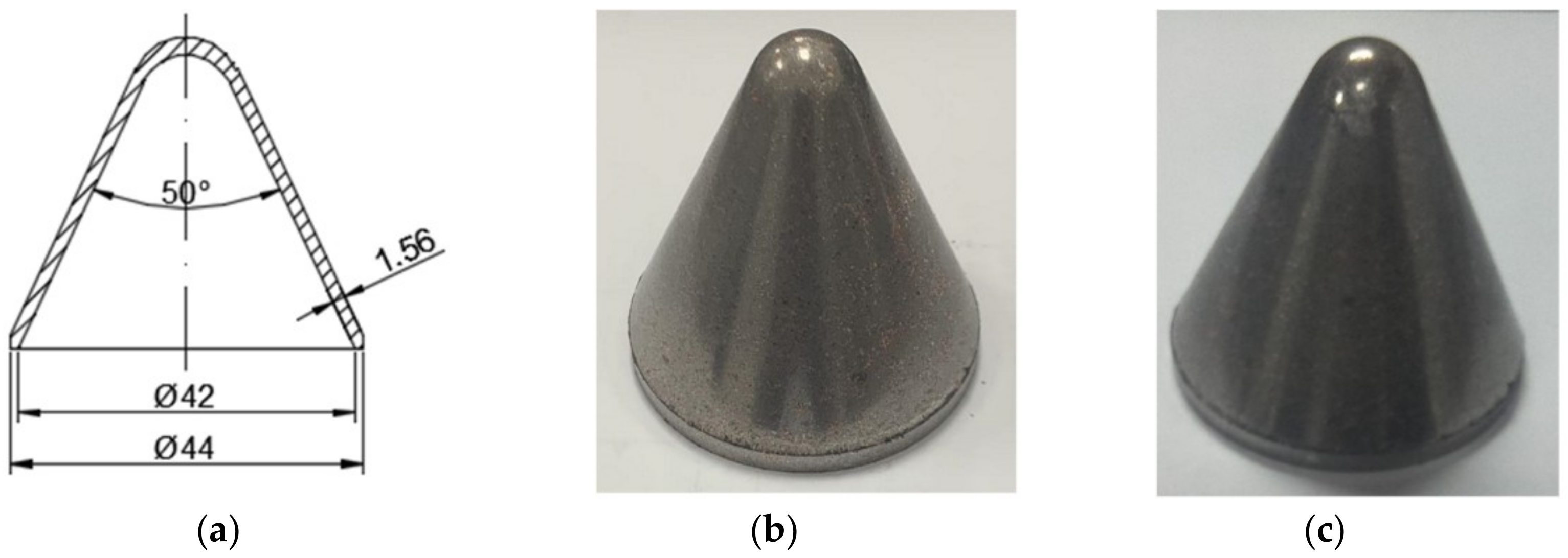
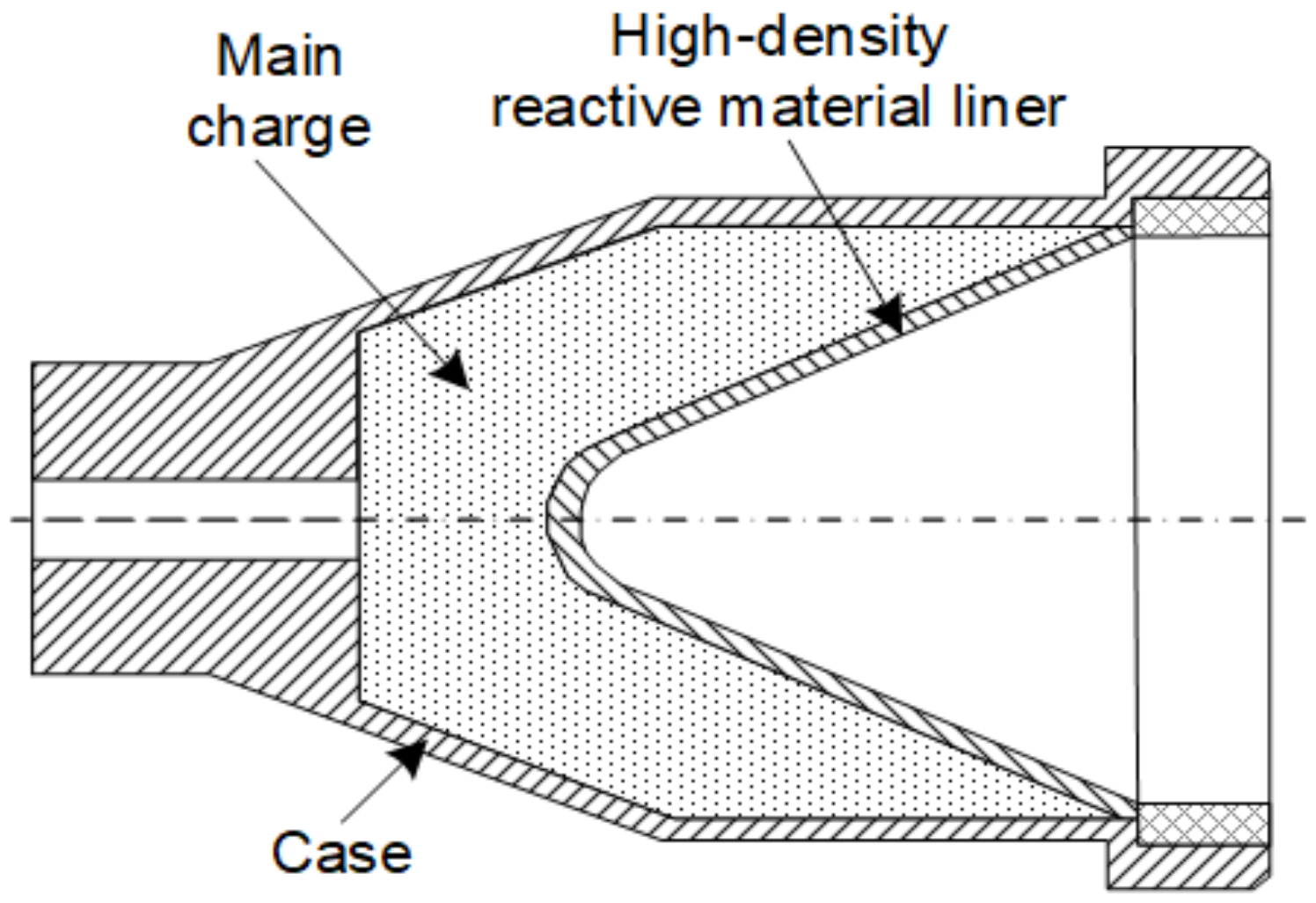

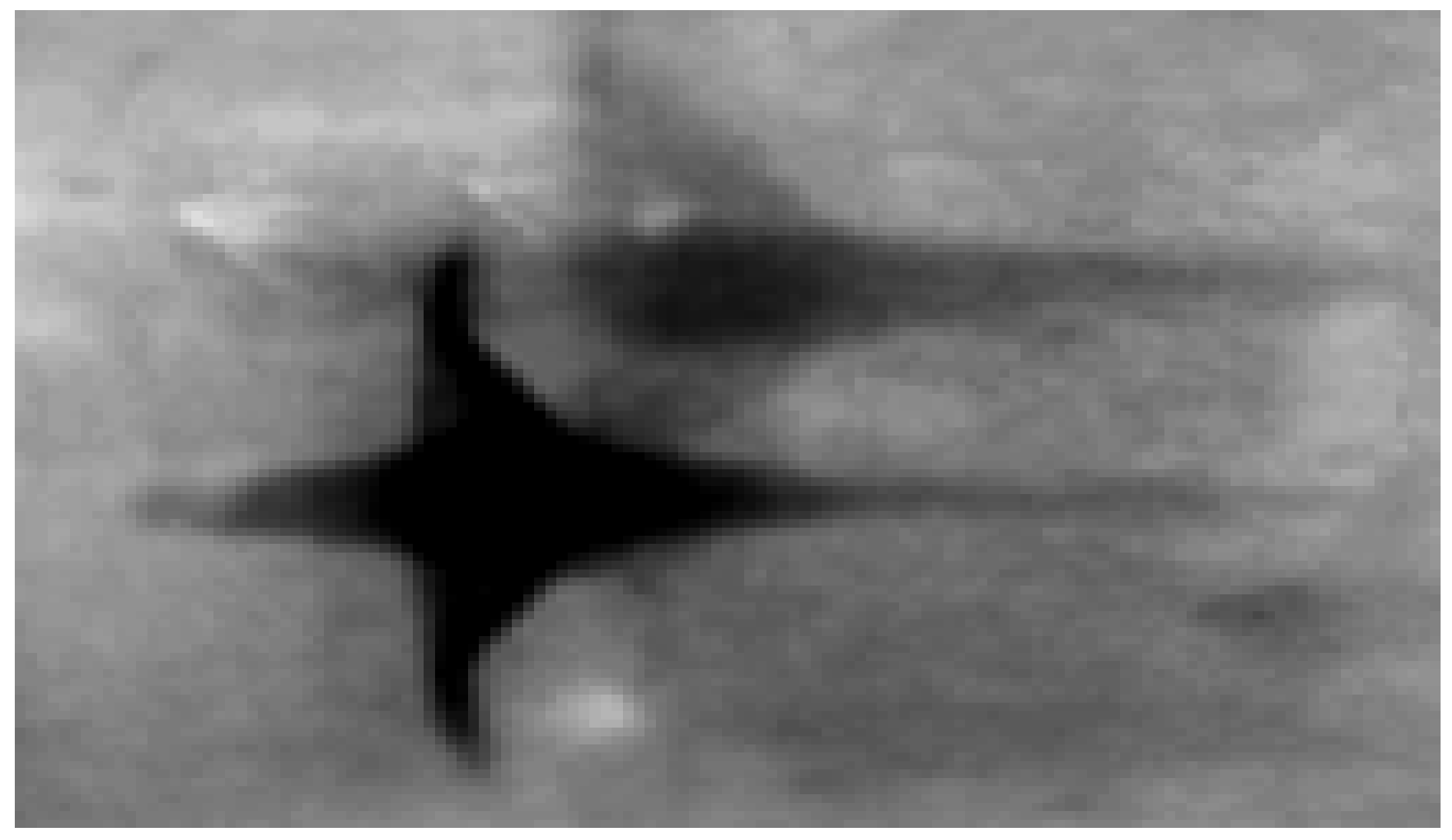
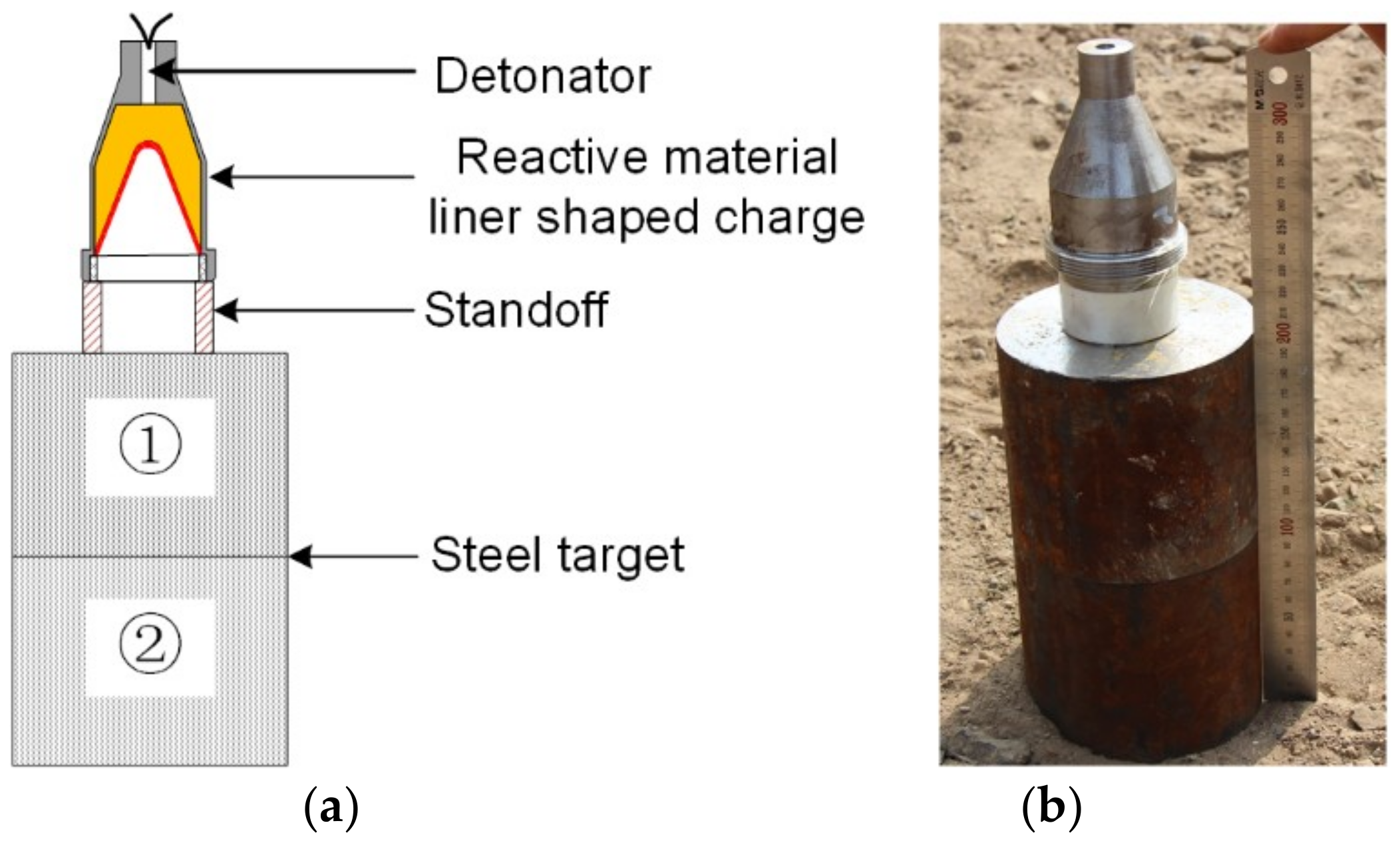
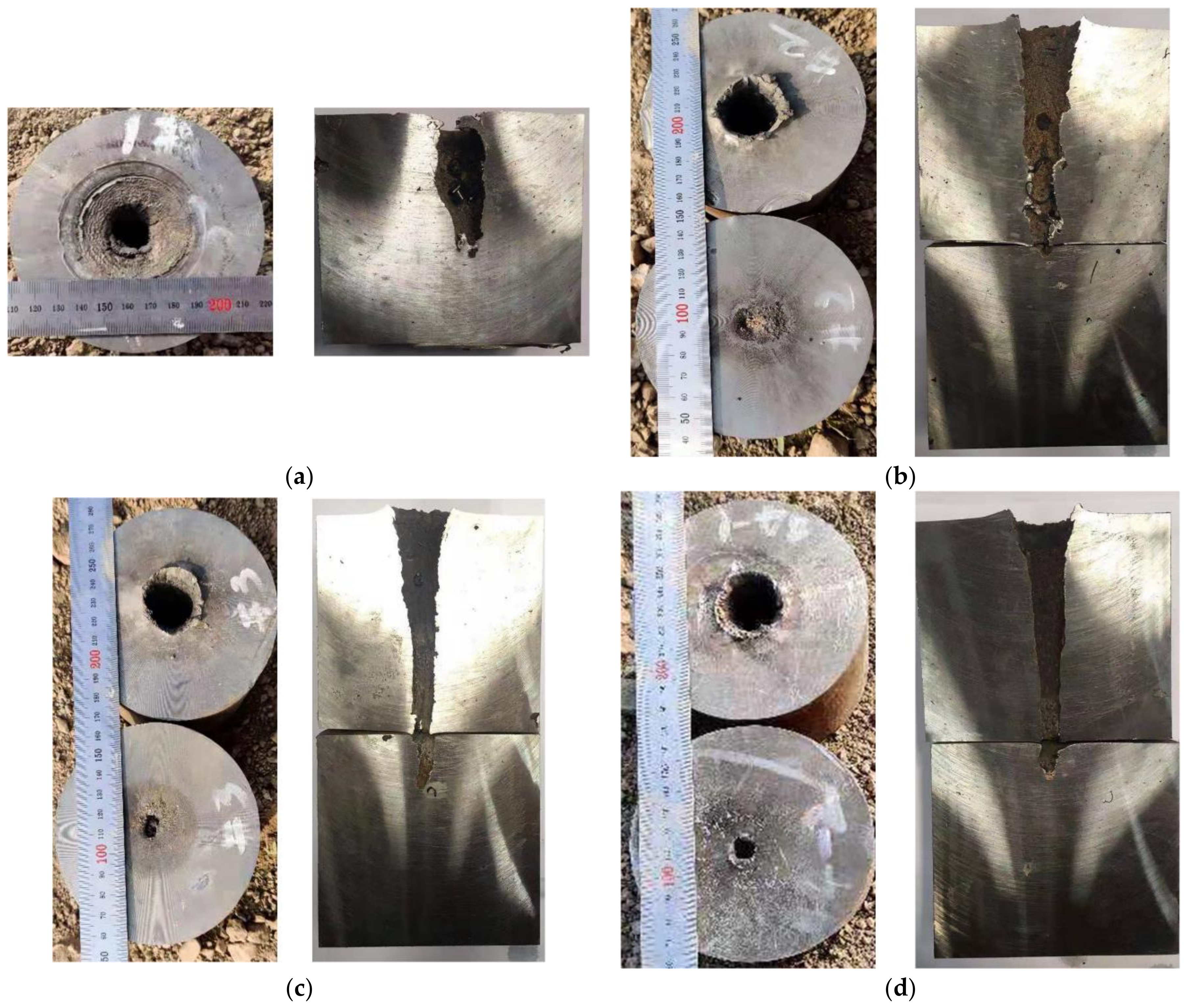
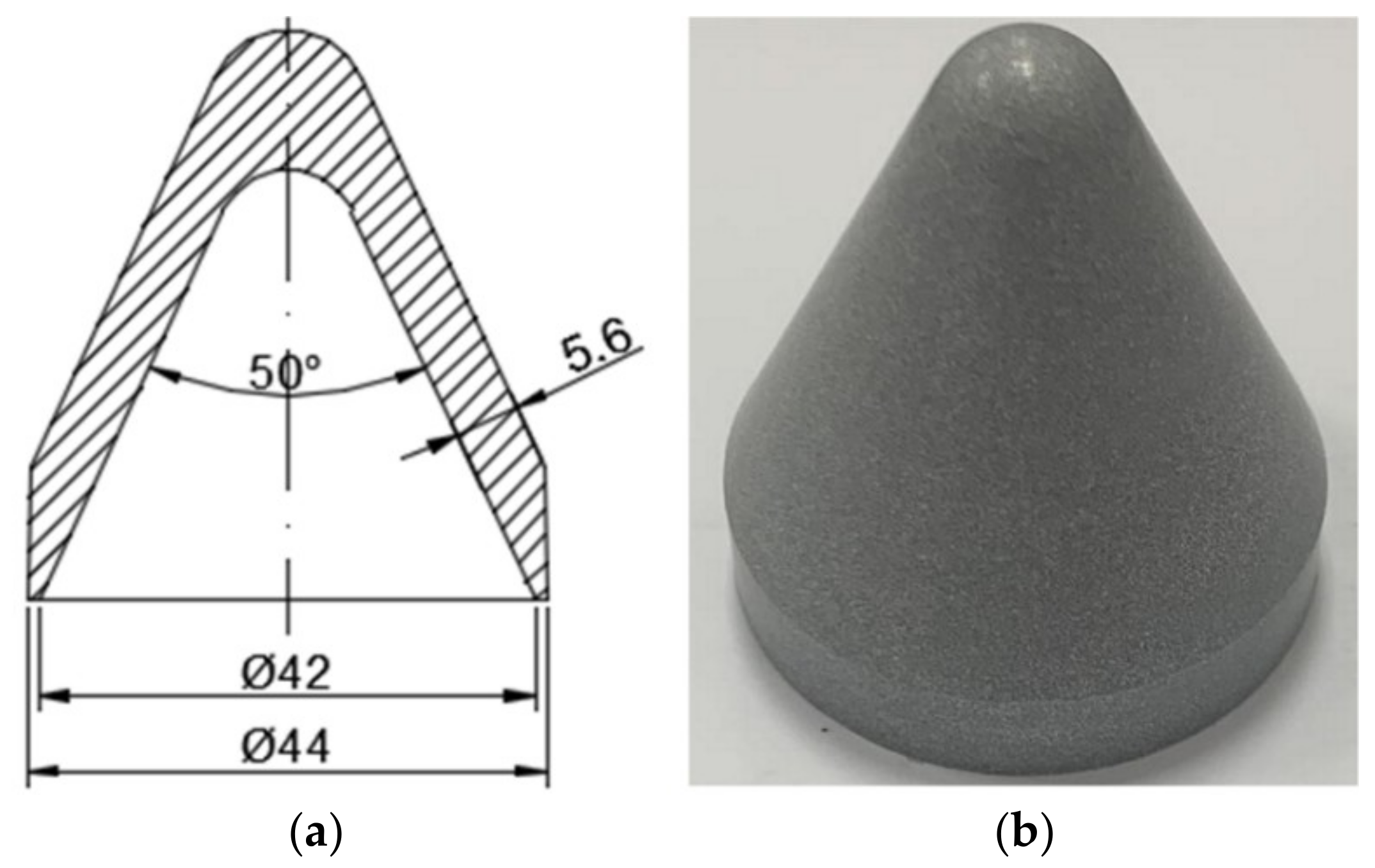

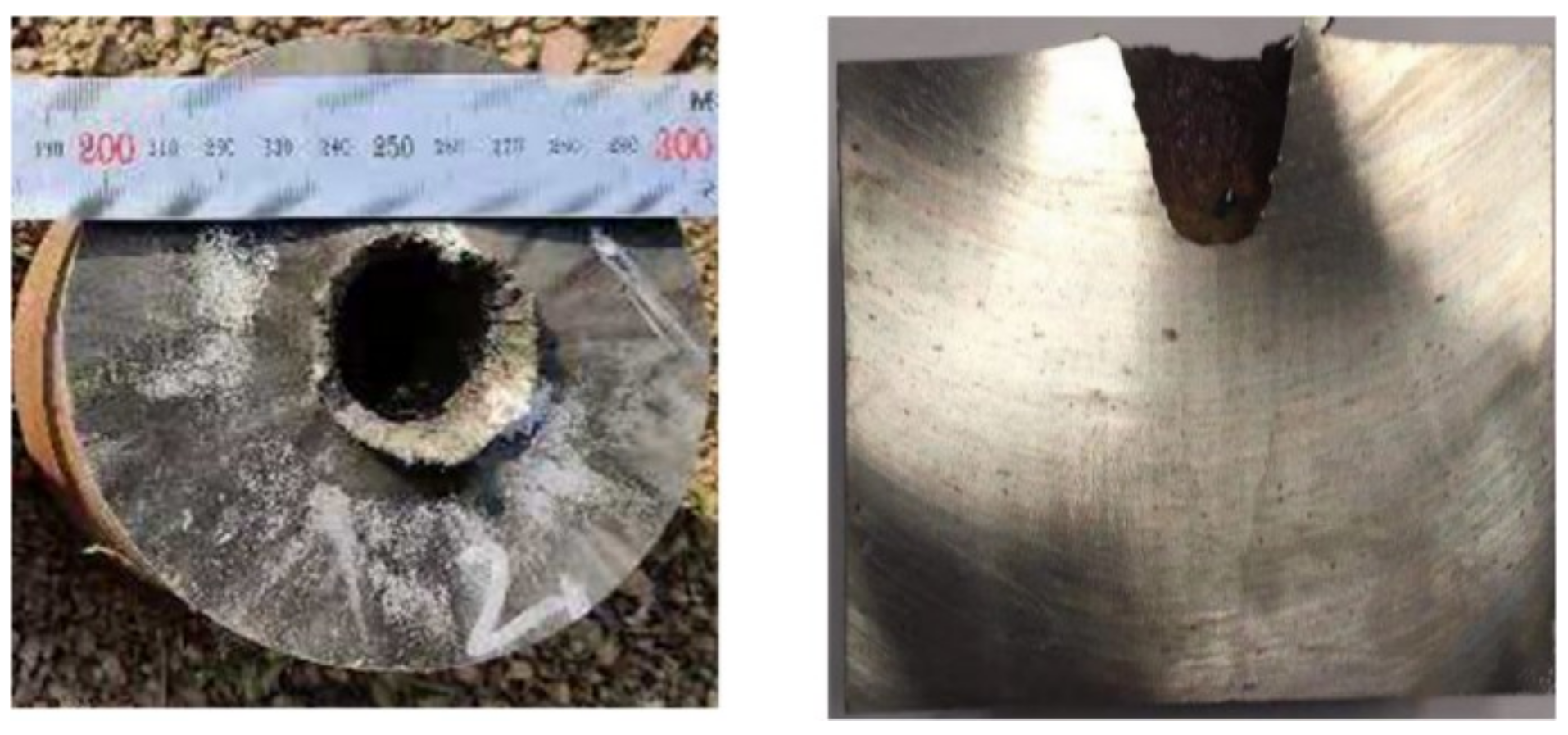
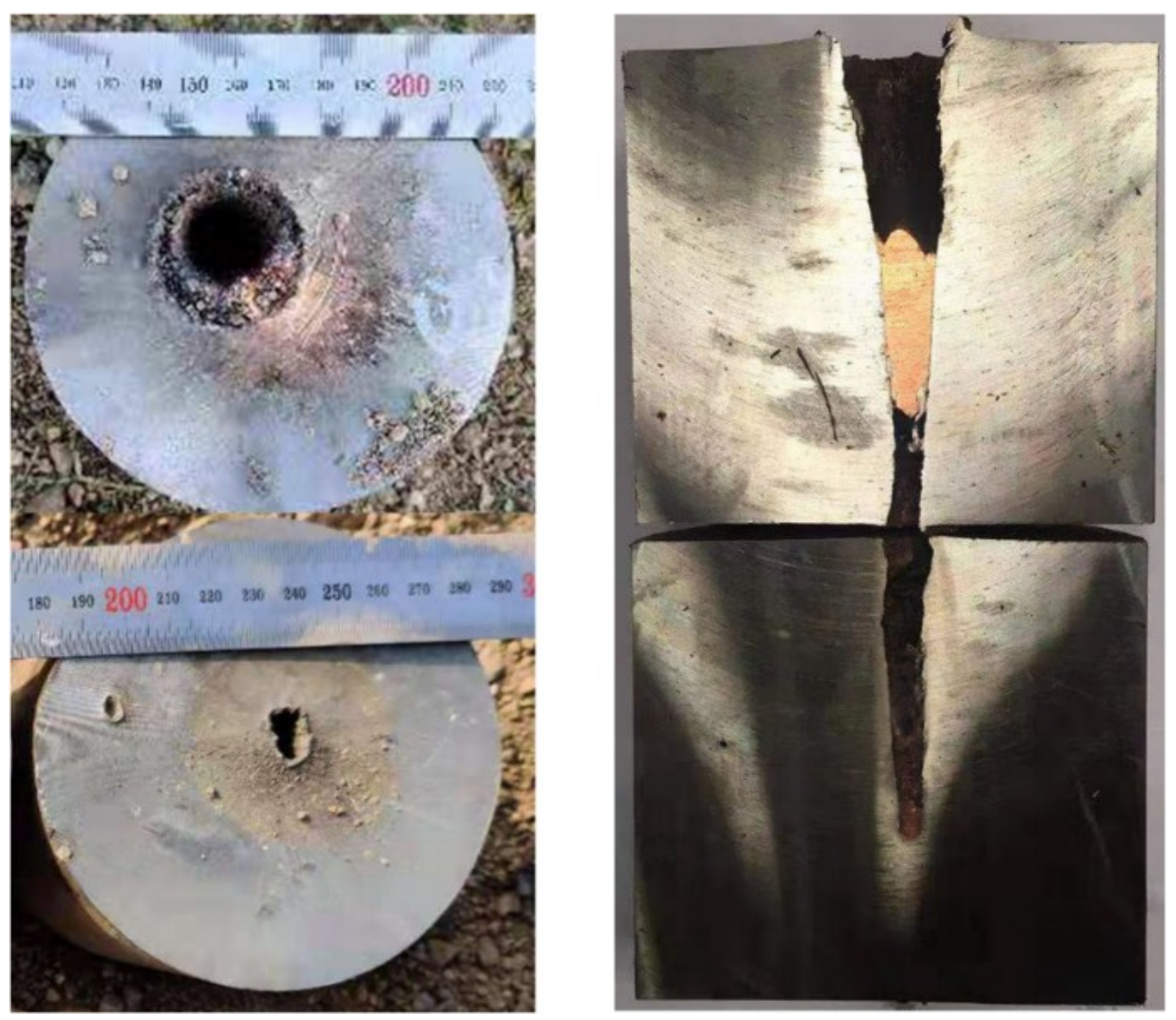
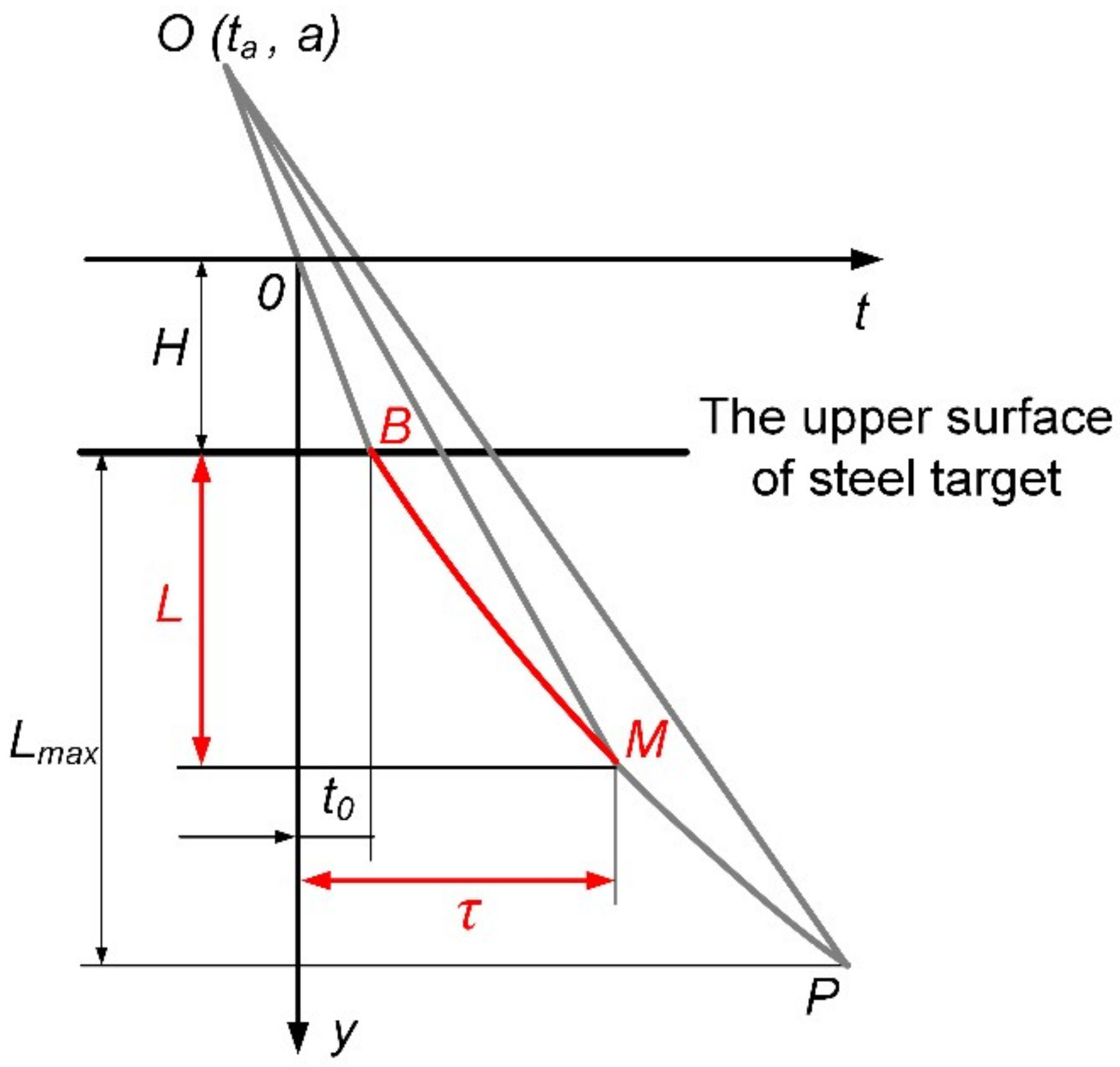

| No. | Standoff (CD) | Penetration Depth (CD) | Penetration Hole Diameter (CD, Charge Diameter) | ||
|---|---|---|---|---|---|
| Entrance of ① Plate | Exit of ① Plate | Entrance of ② Plate | |||
| #1 | 0.5 | 1.36 | 0.97 | - | - |
| #2 | 1.0 | 2.39 | 0.71 | 0.24 | 0.28 |
| #3 | 1.5 | 2.82 | 0.62 | 0.21 | 0.24 |
| #4 | 2.0 | 2.64 | 0.55 | 0.19 | 0.21 |
| Materials of Liner | Density (g/cm3) | Standoff (CD) | Penetration Depth (CD) | Penetration Hole Diameter (CD) | ||
|---|---|---|---|---|---|---|
| Entrance of ① Plate | Exit of ① Plate | Entrance of ② Plate | ||||
| PTFE/W/Cu/Pb | 8.51 | 1.5 | 2.82 | 0.62 | 0.21 | 0.24 |
| PTFE/Al | 2.30 | 1.5 | 0.70 | 0.69 | - | - |
| Cu | 8.90 | 1.5 | 3.85 | 0.48 | 0.18 | 0.21 |
© 2019 by the authors. Licensee MDPI, Basel, Switzerland. This article is an open access article distributed under the terms and conditions of the Creative Commons Attribution (CC BY) license (http://creativecommons.org/licenses/by/4.0/).
Share and Cite
Guo, H.; Xie, J.; Wang, H.; Yu, Q.; Zheng, Y. Penetration Behavior of High-Density Reactive Material Liner Shaped Charge. Materials 2019, 12, 3486. https://doi.org/10.3390/ma12213486
Guo H, Xie J, Wang H, Yu Q, Zheng Y. Penetration Behavior of High-Density Reactive Material Liner Shaped Charge. Materials. 2019; 12(21):3486. https://doi.org/10.3390/ma12213486
Chicago/Turabian StyleGuo, Huanguo, Jianwen Xie, Haifu Wang, Qingbo Yu, and Yuanfeng Zheng. 2019. "Penetration Behavior of High-Density Reactive Material Liner Shaped Charge" Materials 12, no. 21: 3486. https://doi.org/10.3390/ma12213486
APA StyleGuo, H., Xie, J., Wang, H., Yu, Q., & Zheng, Y. (2019). Penetration Behavior of High-Density Reactive Material Liner Shaped Charge. Materials, 12(21), 3486. https://doi.org/10.3390/ma12213486







